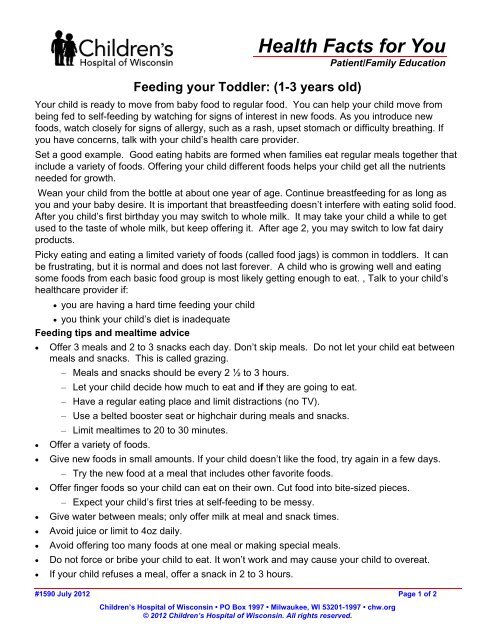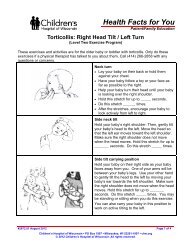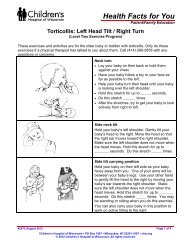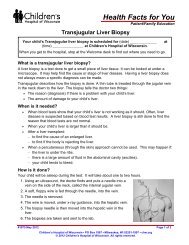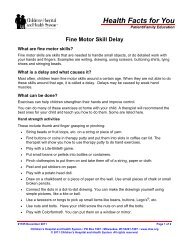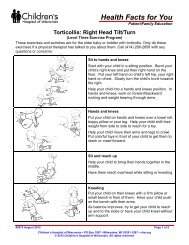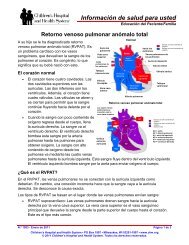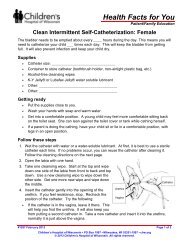Feeding your Toddler - Children's Hospital of Wisconsin
Feeding your Toddler - Children's Hospital of Wisconsin
Feeding your Toddler - Children's Hospital of Wisconsin
You also want an ePaper? Increase the reach of your titles
YUMPU automatically turns print PDFs into web optimized ePapers that Google loves.
Health Facts for YouPatient/Family Education<strong>Feeding</strong> <strong>your</strong> <strong>Toddler</strong>: (1-3 years old)Your child is ready to move from baby food to regular food. You can help <strong>your</strong> child move frombeing fed to self-feeding by watching for signs <strong>of</strong> interest in new foods. As you introduce newfoods, watch closely for signs <strong>of</strong> allergy, such as a rash, upset stomach or difficulty breathing. Ifyou have concerns, talk with <strong>your</strong> child’s health care provider.Set a good example. Good eating habits are formed when families eat regular meals together thatinclude a variety <strong>of</strong> foods. Offering <strong>your</strong> child different foods helps <strong>your</strong> child get all the nutrientsneeded for growth.Wean <strong>your</strong> child from the bottle at about one year <strong>of</strong> age. Continue breastfeeding for as long asyou and <strong>your</strong> baby desire. It is important that breastfeeding doesn’t interfere with eating solid food.After you child’s first birthday you may switch to whole milk. It may take <strong>your</strong> child a while to getused to the taste <strong>of</strong> whole milk, but keep <strong>of</strong>fering it. After age 2, you may switch to low fat dairyproducts.Picky eating and eating a limited variety <strong>of</strong> foods (called food jags) is common in toddlers. It canbe frustrating, but it is normal and does not last forever. A child who is growing well and eatingsome foods from each basic food group is most likely getting enough to eat. , Talk to <strong>your</strong> child’shealthcare provider if:• you are having a hard time feeding <strong>your</strong> child• you think <strong>your</strong> child’s diet is inadequate<strong>Feeding</strong> tips and mealtime advice• Offer 3 meals and 2 to 3 snacks each day. Don’t skip meals. Do not let <strong>your</strong> child eat betweenmeals and snacks. This is called grazing.– Meals and snacks should be every 2 ½ to 3 hours.– Let <strong>your</strong> child decide how much to eat and if they are going to eat.– Have a regular eating place and limit distractions (no TV).– Use a belted booster seat or highchair during meals and snacks.– Limit mealtimes to 20 to 30 minutes.• Offer a variety <strong>of</strong> foods.• Give new foods in small amounts. If <strong>your</strong> child doesn’t like the food, try again in a few days.– Try the new food at a meal that includes other favorite foods.• Offer finger foods so <strong>your</strong> child can eat on their own. Cut food into bite-sized pieces.– Expect <strong>your</strong> child’s first tries at self-feeding to be messy.• Give water between meals; only <strong>of</strong>fer milk at meal and snack times.• Avoid juice or limit to 4oz daily.• Avoid <strong>of</strong>fering too many foods at one meal or making special meals.• Do not force or bribe <strong>your</strong> child to eat. It won’t work and may cause <strong>your</strong> child to overeat.• If <strong>your</strong> child refuses a meal, <strong>of</strong>fer a snack in 2 to 3 hours.#1590 July 2012 Page 1 <strong>of</strong> 2Children’s <strong>Hospital</strong> <strong>of</strong> <strong>Wisconsin</strong> • PO Box 1997 • Milwaukee, WI 53201-1997 • chw.org© 2012 Children’s <strong>Hospital</strong> <strong>of</strong> <strong>Wisconsin</strong>. All rights reserved.
How much food should my child eat?Food GroupGrains:BreadCooked CerealDry CerealRice, noodles, pastaFruit:CannedFreshJuiceVegetableDairy:MilkYogurtCheeseProtein:Meat, poultry, fishDry beansEggsPeanut ButterServing Size½ slice¼ - 1/3 cup¼ - ½ cup¼ - 1/3 cup2-3 tablespoons¼ - ½ small¼ - 1/2 cup2-3 tablespoons½ cup½ cup½ ounce½ - 1 ounce1/3 cup, cooked½ - 1 each1 tablespoonError! No text <strong>of</strong> specified style in document.• Start with a small amount on the plate and add more food to the plate as the child eats.• Foods with protein and fat are important for toddler development and growth. These foods canbe difficult for toddlers to accept and eat. It is important to include foods with protein and fat ateach meal and snack.• Healthy meals should include:– At least a grain, protein, and fruit or vegetable.– An age appropriate milk.Prevent ChokingHave <strong>your</strong> child safe, seated and supervised at meal and snack times.Foods to avoid:• Nuts • Whole grapes • Raw hard vegetables• Raisins• Hot Dogs**Cut and quartered hot dogs are ok.Use Caution when serving these foods:• Dried Fruits• Popcorn• Chips• Peanut Butter• Use the My Plate as a pattern for serving healthymeals to <strong>your</strong> child and family.• Half <strong>of</strong> the plate should be fruits and vegetables.• Use the picture to guide food choices and thetable to guide portion sizes.• Hard candy and jelly beans• PretzelsALERT: Call <strong>your</strong> child’s doctor, nurse, or clinic if you have any questions or concernsor if <strong>your</strong> child has special health care needs that were not covered by this information.This teaching sheet is meant to help you care for <strong>your</strong> child. It does not take the place <strong>of</strong> medical care. Talkwith <strong>your</strong> healthcare provider for diagnosis, treatment, and follow-up.#1590 July 2012 Page 2 <strong>of</strong> 2


